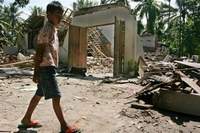Indonesian earthquake death toll continues to grow as rescuers clear the rubble
Thousands of exhausted and grieving survivors dug through their crumpled homes Sunday searching for clothes, food and valuables after a powerful earthquake hit central Indonesia, killing more than 3,700.

The magnitude-6.3 quake struck early Saturday and injured thousands more in the heart of densely populated Java island, in the country's worst disaster since the 2004 tsunami. It also triggered fears that a nearby rumbling volcano would erupt.
The disaster zone stretched across hundreds of square kilometers (square miles) of mostly farming communities in Yogyakarta province. The worst devastation was in the town of Bantul, where more than 2,400 people were killed and 80 percent of the homes were flattened.
"I have to start my life from zero again," said Poniran, whose 5-year-old daughter Ellie was killed in the quake.
Poniran dug up his still-breathing daughter from the rubble of her bedroom, but she died in a hospital awaiting treatment along with hundreds of others.
"Her last words were 'Daddy, Daddy,"' he said.
Tens of thousands of people spent the night Saturday sleeping in any open space available - on streets, in cassava fields, even on the narrow paths between rice fields. Power and telephone service was out across much of the region, adding to the terror of aftershocks.
About 450 aftershocks had shaken the region as of midday Sunday, with the strongest measuring magnitude 5.2, said Handi, an official at the Meteorology and Geophysics Agency who uses only one name.
Survivors searched the ruins of their homes on Sunday for anything still usable and complained that they hadn't received any aid.
"We're short of everything - clothes, food, water, all are gone. We are poor people, but our lives still matter," said Budi Wiyana, 63, whose house was destroyed.
Doctors struggled to care for the injured, hundreds of whom were lying on plastic sheets, straw mats and even newspapers outside overcrowded hospitals, some hooked to intravenous drips dangling from trees.
Bloodstains littered the floor at Yogyakarta's Dr. Sardjito Hospital, along with piles of soiled bandages and used medical supplies.
"We are short of surgeons," said Alexander, a doctor who goes by one name. "There are still so many critically injured people here."
In villages visited by reporters on Sunday, residents said there were no people or bodies still trapped under the rubble of the houses, mostly simple brick and wood structures.
Most of the dead were buried in village graveyards within hours of the disaster, in line with Islamic tradition.
In Peni village on Bantul's outskirts, villagers set up simple clinics to treat injuries, but were hampered by shortages of medicine and equipment. A group of women cooked catfish caught in a nearby pond for dozens of people huddled under a large tent.
The earthquake hit at 5:54 a.m., caving in tile roofs and sending walls crashing down. Survivors screamed as they ran from their homes, some clutching bloodied children and the elderly.
The quake, which struck near the famed Borobudur temple complex, was the latest in a series of disasters to hit Indonesia - including the 2004 tsunami that ravaged Aceh province, terrorist attacks, a widening bird flu outbreak and the threat of eruption from nearby Mount Merapi.
The quake's epicenter was 80 kilometers (50 miles) south of Merapi, and activity increased soon after the temblor. A large burst spewed hot clouds and sent debris cascading some 3.5 kilometers (two miles) down its western flank. No one was injured because nearby residents had already been evacuated.
Bambang Dwiyanto of the Energy and Mineral Ministry could not say whether the quake caused the volcanic activity but warned that it could trigger a larger eruption.
"It will influence the activities of Mount Merapi, particularly in the lava dome," said Dwiyanto, head of the ministry's geological division.
Indonesia, the world's largest archipelago, is prone to seismic upheaval due to its location on the so-called Pacific "Ring of Fire," an arc of volcanos and fault lines encircling the Pacific Basin. It has the largest number of volcanos in the world - 76.
International agencies and other nations pledged millions of dollars of aid.
President Susilo Bambang Yudhoyono ordered the army to evacuate victims and arrived with a team of Cabinet ministers to oversee rescue operations.
At least 3,765 people were killed in the quake, command post officials from the affected districts told The Associated Press. The only foreigner reported killed or injured was a man from the Netherlands.
Bantul is about 2,230 kilometers (1,390 miles) southeast of Aceh province, where 131,000 people died in a December 2004 tsunami triggered by a magnitude-9.1 earthquake under the sea.
Officials said the famed 7th century Borobudur Buddhist temple, one of Indonesia's most popular tourist attractions, was not affected by the quake. Nearby Prambanan, a spectacular Hindu temple to the southeast, suffered some damage but it was not immediately clear how much, officials said.
Close to 1 million tourists visit the temples every year.
Subscribe to Pravda.Ru Telegram channel, Facebook, RSS!





